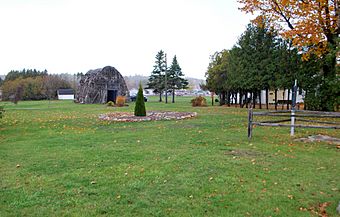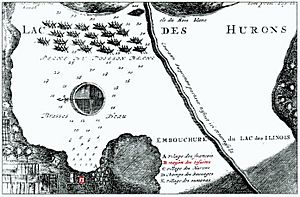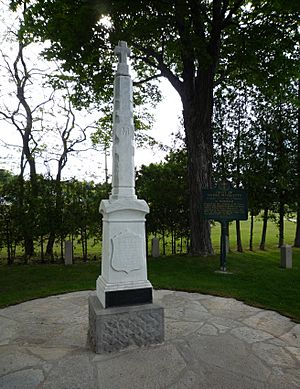Marquette Street Archaeological District facts for kids
Quick facts for kids |
|
|
Marquette Street Archaeological District
|
|

Region of archaeological district
|
|
| Location | Near the St. Ignace Mission, St. Ignace, Michigan |
|---|---|
| Area | 6 acres (2.4 ha) |
| NRHP reference No. | 82000541 |
| Added to NRHP | October 29, 1982 |
The Marquette Street Archaeological District is a special place in St. Ignace, Michigan. It's an archaeological site, which means it's where scientists study old things to learn about people who lived long ago. This district is near the St. Ignace Mission and covers about 6 acres. It includes an old village, a cemetery, and one building. This important site was added to the National Register of Historic Places in 1982.
Contents
Who Lived Here Long Ago?

The Petun people were the first known inhabitants of this area. They originally lived near Georgian Bay, but were forced to move by the Iroquois tribe. They traveled far, first to what is now Wisconsin.
Around 1670, the Petun moved again, this time because of the Sioux tribe. They settled in the area that is now St. Ignace. By this time, many Petun had been lost due to sickness and wars.
The Mission and the Village
A few years later, a French missionary named Père Jacques Marquette started his mission near the Petun village. The village was quite large, home to between 500 and 800 people.
The Petun lived in this location until 1701. That's when Antoine de la Mothe Cadillac convinced them to move south. They joined him when he founded the city of Detroit.
What Have We Found?

Archaeologists have dug at the Petun village site in St. Ignace many times. They first started in the 1970s. More digs happened in 1983-86, 1996–97, and 2001.
Discoveries at the Site
These excavations have uncovered exciting evidence of how the Petun lived. They found signs of their longhouses, which were long, shared homes. They also found hearths, which were places for fires used for cooking and warmth.
Archaeologists also saw how the Petun interacted with European settlers. They found that the Petun were clever at reusing things. For example, they turned pieces of European glass and metal into weapons and beautiful ornaments.
Blending Cultures
The Petun also started to include parts of Christian worship into their own traditions. Even though they were forced to move many times, and their numbers became smaller, their unique culture stayed strong. They kept their identity despite being exposed to European goods and ways of life.



